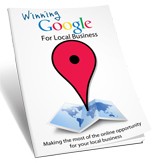
 License Type: Personal Use
License Type: Personal Use  File Size: 681 KB
File Size: 681 KB File Type: ZIP
File Type: ZIP
 SKU: 55116
SKU: 55116  Shipping: Online Download
Shipping: Online Download
Ebook Sample Content Preview:
So we've staked a claim, we've built on our land (in the right way), now it's time to develop some roads onto our property. As you can imagine, an island cut off from the rest of the world is not going to receive much traffic. The island may be beautiful, it may have all the right things in all the right places, but without roads in, it will be very difficult for people to chance upon it.
In the last chapter we skimmed over what is called on page optimisation factors. These are the elements you put in place on your website.
There is also off page optimization. These are things that you can put in place that are not part of your actual website, but point back to it from other places on the internet.
Again, these factors are another important element in how much visibility we have in the search engines, particularly for more competitive search terms.
This is achieved in many ways, and by intelligently using the opportunities that we now have on the Internet, we can build many roads that lead to our site.
These might be links from social media websites like Facebook or Twitter, they might be reviews in Google+ local, or links from YouTube videos that you have created to advertise your business.
The important thing is that we concentrate on making sure that these roads are in place, and we continue to build more and more opportunities for people to find their way our main web properties.
Several factors come into play when we look at this road building exercise.
Not all links are equal, and some of the sites where we can begin to build links back to our own website have more authority than others (by this I mean that Google will place more weight on some links than others).
Having said this however, the important thing is that we begin to build a catalogue of links back to our site from other places on the Internet. Some of them may be important, others less so, but every road back to our site is helpful.
As I said before, there are many ways that we can achieve this. To name just a few, we can post articles on article sites like ezinearticles.com or Squidoo.com. We can develop our Facebook fan page profile. We can make sure that our Google+ local profile is fully complete and optimised. It could be RSS feeds, a blog, links from Twitter or links from the many bookmarking and directory sites that proliferate the web. You get the picture.
A good SEO strategy will incorporate all of these and more. And all the time, while we put these other things in place, we can continue to build our own website with fresh articles and content.
Turning Visitors Into Leads
It is one thing to get your site set up, and to get people coming to your site, but there still remains one more question we need to ask...
What happens when they arrive there?
We are now going to ask a few more questions. If you answer them clearly it can make a big difference to your bottom line.
It is so important as a local business to think carefully about what you present to your website visitors when they arrive on your site.
What do you want them to do? And do you make it easy for them to do it? Is it obvious?
We want to turn our website visitors into customers. We want them to become fresh leads for our business.
Take a look at your site.
Is your contact information clearly visible? Do you have a working contact form that people can easily access to get in touch with you? Is your website front page confusing or is it easy to read and navigate?
All of these questions need to be answered, so our visitors can quickly become customers.
Always remember, when people are searching the Internet they will not hang around on a website that is confusing or difficult to understand or read. We want to make it simple and clear for people when they arrive at our site.
Think of the one thing, above everything else, that you want to present to your customer, and the one action that you would like them to take when they come there, and make it abundantly clear how to do that one thing.
One of the ways that we have helped local businesses do this is by setting up an e-mail capture form on their web site. You may even offer an incentive for people to share their information with you, such as a free report, or a discount when they visit your store or business.
There are several creative and interactive ways to accomplish interaction. For our clients we have utilized quizzes, questionnaires, free eBooks or reports, access to an informative video, or a coupon or discount code. The list is endless, but what is important is the fact that we offer something of value in exchange for contact details, that then allow us to contact that prospect again in the future.
As I have said, this will allow you to contact those visitors to your site again and again in the future, with special offers, seasonal sales, and any other information that you feel will be relevant to your market. It is a great way to bring people back to your website again, instead of them taking one look, never to return.
I always suggest that a professional e-mail company is used if this approach is taken. There are many different ones available such as Aweber, GetResponse, SendReach ot Mailchimp.
Each will allow you to build a great and responsive list of leads and buyers that you can sell to again and again.
The Mobile Revolution
Following on from our last chapter we also need to recognize that the world has gone mobile. Unless you've been living in a hole for the last decade, you will not be surprised to find out that mobile usage is growing at an unbelievable rate.
Your customers are mobile. Are you?
Many local businesses are now realizing that not only do they need a great website for people sitting at home on their computers, they also need a very cool mobile version of the site for people who are coming to them using mobile devices.







